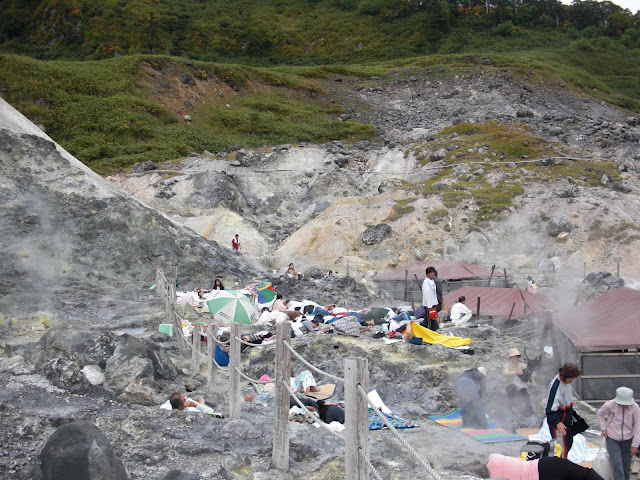On Friday 28th August I got on a night bus in Honjo and 9 hours later I got off in Tokyo. I met up with another ALT who works in Akita city. We hung around for a bit waiting for restaurants and toilets to open. Strangely many of the toilets in Tokyo station close for the night!
We were on our way to
Mt. Fuji, the tallest mountain in Japan, standing at 3,776m (12,388 ft).
We got a bus to the 5th station, which is at an altitude of 2,305m (higher than Mt. Chōkai). After a few preparations and a light stretch we were more that ready to head off,
unprepared up Mt. Fuji. It about 14:30 when we set off and the weather was a little cloudy.

There were way more people on the mountain that I expected, even though every website we had read beforehand warned of human traffic. After about a half an hour or so we could see the lines of people climbing the mountain in stop-start motion. About the same time we noticed a different path that only had people descending on it. So we decided to try that trail!
As it turned out there are 2 main routes on the side we took (Yoshida trail; 吉田ルート), one for going up and one for coming down. So we were going up the down route. And luckily for us it had no traffic what-so-ever. There were plenty of people coming down but they did not interfere with our assent nor did we interfere with their descent. It was a more difficult route however, as the trail was all loose stones.
We hiked for up and up, gradually taking breaks more regularly. We were lucky enough to only encounter one rain shower on the way up, and even that only lasted about 10 minutes.

We were making really good time. Too good in fact, as we reached the 8th station at about 6pm. Our plan was to get to the top in time to watch the sun rise. But we really hadn't researched it very well at all. We were able to buy pot noodles at the 8th station which was a welcome change to the many
onigiris we were eating!
I asked in the cabins if there was space, so that we could sleep for a few hours before continuing to the top. But all the cabins were completely booked up. So we resorted to buying some hot
sake, putting on all our warm clothes and trying to sleep outside one of the cabins!
We were not the only one to have not reserved a cabin. We also met a French couple who were in the same boat as ourselves. We all huddles together, kinda like emperor penguins, to try conserve body heat. But with no blankets, and lying on the cold clay, we were fighting a loosing battle. We resorted to taking regular trips to the toilets, which were surprisingly heated! We would have slept there if there wasn't a horrible stench.

At about 12:30am we gave up on trying to get sleep and decided to head for the top; as we knew climbing would warm us up. So with our headlamps on, we slowly hiked the remaining 900m to the top. Along the way people were randomly sleeping along the path, and although they were smart enough to bring sleeping pads and blankets, they still did not look warm!
By 2:30am we had reached the top of the mountain, and traversed the ridge to the summit at the opposite side of the mountain! This is us standing on the highest point of Japan!

We now had to wait another 2 and a half hours before sunrise! So we found a sheltered area and tried to sleep again. I didn't get any sleep! But looking up at the night sky from the top of Mt. Fuji is quite the sight. There was no clouds above us so we could see the stars which were amazingly bright. I also got to see many shooting stars!
Eventually the sky lost it's grip on complete darkness, and one by one the stars faded. We could then see that there was a sea of clouds (雲海) beneath us. As one part of the horizon was becoming lighter we knew where the sun was going to rise. And the crowds began to arrive. We all awaited the sunrise.

One cloud on the horizon was slightly obscuring the sunrise, but it was very impressive none the less!

The one rather strange thing that happened over this weekend was that I never actually got to see Mt. Fuji! I mean I never got to see it from a distance which was kinda strange! I will have to go again sometime.





















































